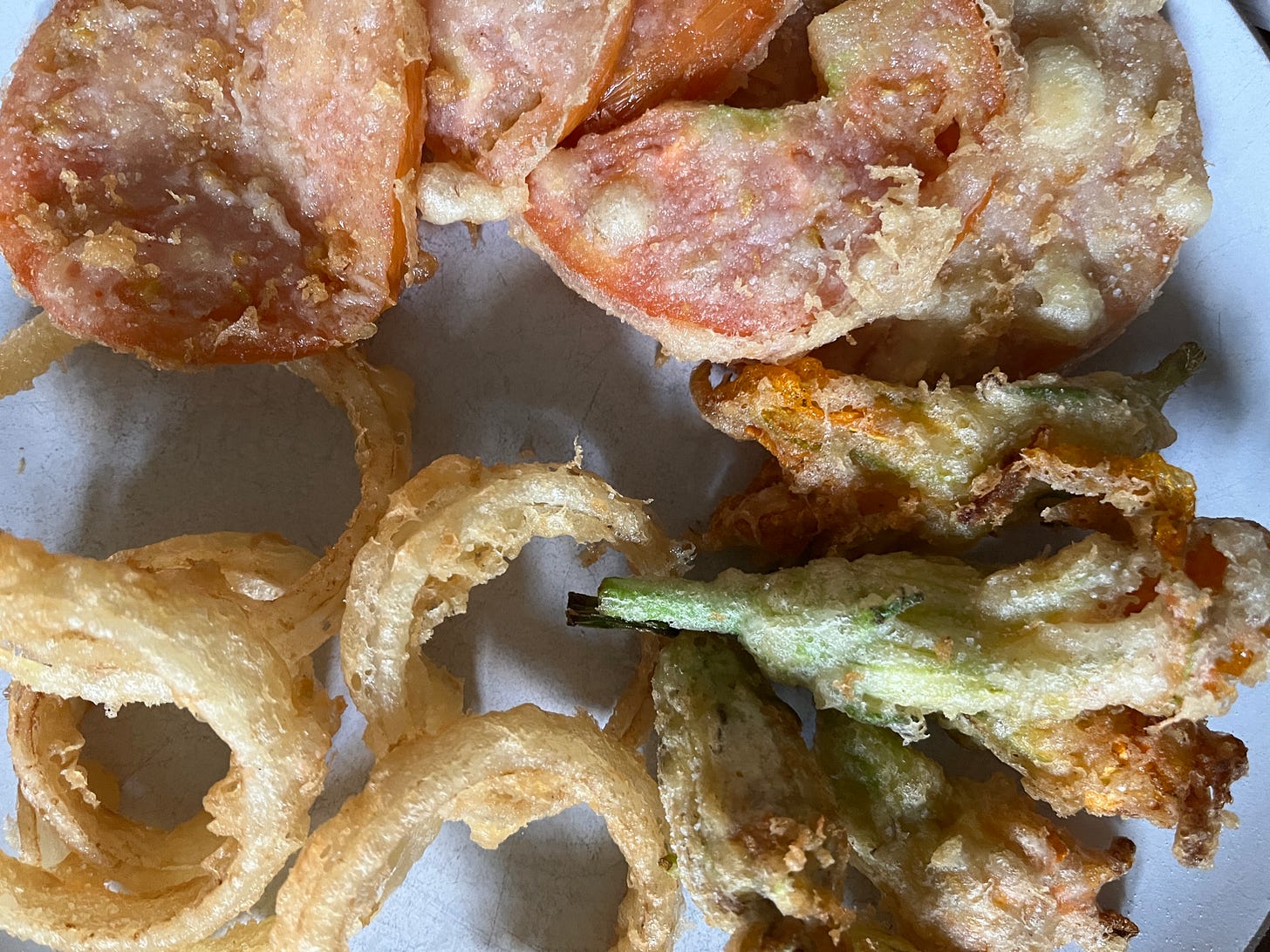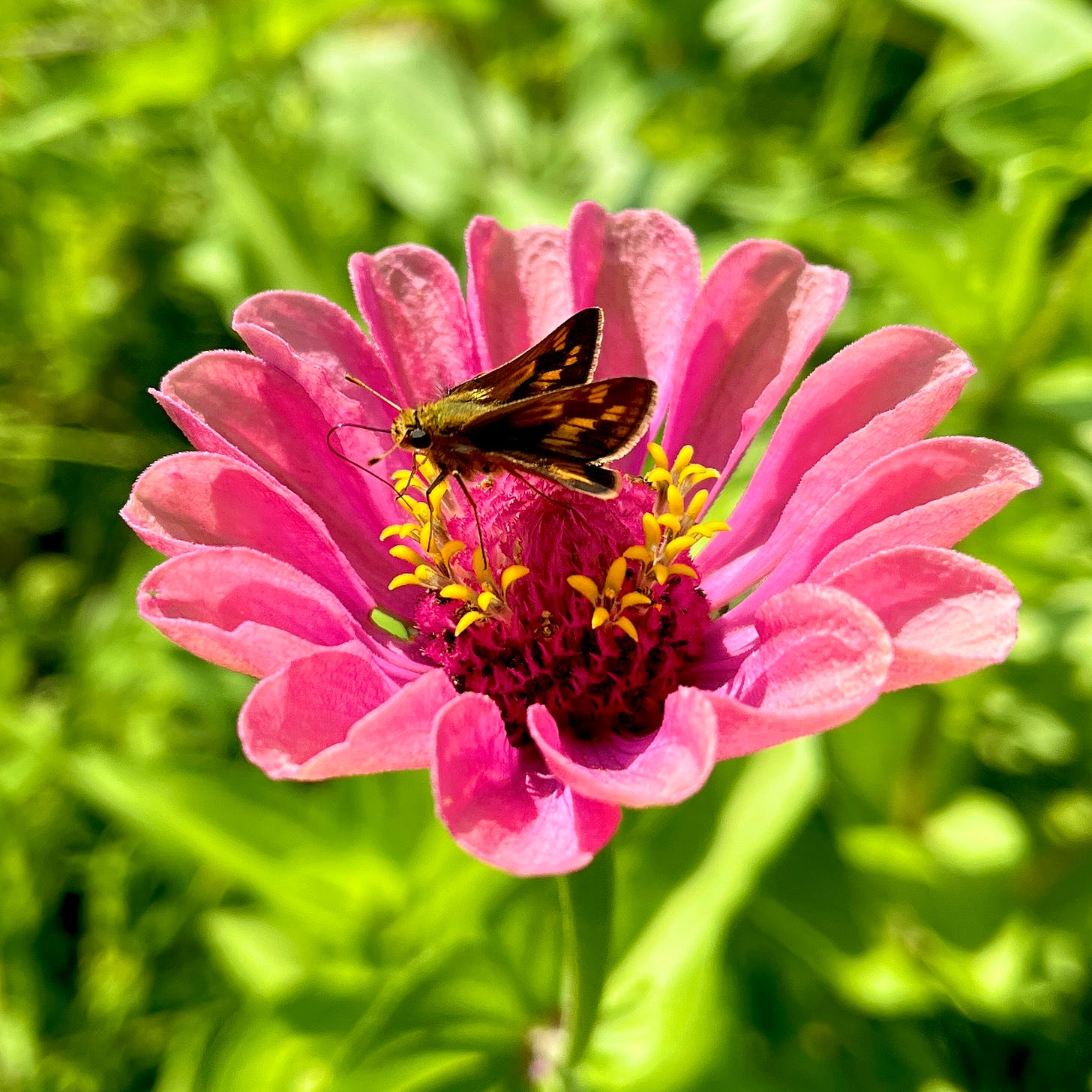Good Flowers Make Good Neighbors
Some fragmented thoughts on random acts of poop-related kindness, bees and butterflies, home, tempura, and wise advice for writing and life
Thursday, August 31
Grand Rapids, Mich.
A Neighborhood Story: Fozzie is a slow walker. If I were on a Manhattan sidewalk and I encountered someone who walks as slowly as he does, I’d be annoyed. Where we live, though, it’s fine.
Last week, I was taking him on his final walk of the evening, by which I mean I was carrying him down the block, for efficiency’s sake. Leslie, who lives around the corner, was out for a stroll. After giving us a friendly wave, she did a double take. She asked what I was doing and whether Fozzie was okay.
I explained that I was trying to get a final poop out of him before we went to bed and that we were walking to the next block, where there are usually cats lurking. Cats enrage Fozzie, I told her, and anger usually makes him poop.
“Oh, I’ll go get my cat,” Leslie said.
“He’ll bark at it,” I said.
“She won’t mind,” she replied.
Fozz and I followed Leslie toward her house, but before we got there, she spotted one of her neighbors’ cats. “There’s one!” she said.
The cat was sitting on the sidewalk, enjoying the evening air. I put Fozz down and nudged him toward the cat. (His eyesight is failing.) After a few seconds, Fozzie finally noticed the cat and immediately growled. The cat sat there, unfazed, staring at Fozzie. Fozzie unleashed his fiercest barks. The cat sat there, unfazed, staring at Fozzie.
Fozzie started toward the cat, but before he could go two steps, he crouched and pooped.
“He pooped!” I announced to Leslie, who was standing on her front porch.
She cheered.
We have good neighbors.
The end.
Our backyard mint is flowering, unfurling countless plumes of tiny, white blossoms. Above the mint, a self-seeded stand of goldenrod has unleashed its seasonal salute too—fluffy arcs of sunshine that, in the breeze, wave their gentle greetings.
This is party time for the pollinators. I’ve spotted all manner of bee and butterfly, wasp and fly, amidst the mint and the goldenrod: bumblebees and honeybees, tons of Cabbage White butterflies, a few skippers, one Northern Crescent, and the occasional monarch. I don’t recognize most of the bees and the butterflies or any of the wasps or flies; I only learn their names with the help of a quick search on my phone.
That I can’t name more of them signals my lack of education and my untrained eyes. It also speaks to how we’re drawn to celebrity, even when it comes to animals. But what does that mean for the world they inhabit and for our less-famous neighbors?
A few decades ago, conservation biologists coined the term “charismatic megafauna” to describe large animals we instantly recognize and adore— pandas, tigers, lions, elephants, and the like. (Another example: the cheetah that drew Caleb and me to Botswana and South Africa last month.) Alongside these creatures, there are also smaller, no less beloved species—what one might call charismatic microfauna, including monarch butterflies and honeybees.
Michigan is native territory for monarchs, but we also have a far more endangered butterfly, called Poweshiek’s Skipperling. Once common across a swath of the Upper Midwest stretching into southern Canada, it’s now restricted to three or four tiny remnants of prairie and meadow in Michigan, Wisconsin, and Manitoba.
Small and brown with a flush of orange on its wings, Poweshiek’s Skipperling has none of the monarch’s captivating visual beauty; to my eye, it might as well be a moth. A census in 2021 counted just 100 specimens; last year, only 70. According to Andrew Bacon of the Michigan Nature Association, “This is probably about as endangered of a species you’re going to find anywhere on the planet.”
The monarch butterfly has at least one advantage over the Poweshiek’s Skipperling: Its storyline is clearer. It needs more protected forest in Mexico during the winter and more milkweed in the U.S. during the summer. I know quite a few people who have cultivated milkweed—I planted a patch next to our driveway—and even built little nurseries to give monarch caterpillars a safe space to grow. Saving the Poweshiek’s Skipperling is an entirely more complicated endeavor.
Scientists don’t know precisely why this butterfly’s numbers have plummeted. It might be habitat degradation; Poweshiek’s Skipperlings seem only to live in native prairies that have never been plowed—and in Michigan, they persist specifically in prairie fens, a rare type of wetland historically shaped by fires and beavers. As with so many species, it has probably suffered as ecosystems have been altered by human fingerprints, its native range fragmented by human settlement. In other words, its world has changed, and experts are struggling to figure out whether it will be able to survive, because there is no way to bring that world back.
Both monarchs and Poweshiek’s Skipperlings have a remarkable inborn sense of place. They know where home is. Somehow it’s etched onto their very beings. They inherently understand where they belong and what they need to thrive. Contrast their stories with that of the honeybee, which isn’t native to these parts—or anywhere in North America—at all.
The most common honeybee, Apis mellifera, comes from Europe and only arrived in the Western Hemisphere during colonial times. With industrialized agriculture, we’ve come to depend on honeybees for our food. All the attention to colony-collapse disorder as well as our growing awareness of the importance of pollinators has helped to stoke an interest in backyard beekeeping.
Yet too much of a good thing can turn out to be not great. As one beekeeper recently told the New York Times, “If you overcrowd any space with honeybees, there is a competition for natural resources, and since bees have the largest numbers, they push out other pollinators, which actually harms biodiversity.”
An experiment some years ago in a national park in the Canary Islands found that the presence of honeybee hives threatened the indigenous population of native bees. Another study suggested that non-native honeybees can disrupt longstanding pollinator-plant relationships. Still another found negative effects on the health of a native California bee when honeybees were introduced onto its territory.
Across North America, there are more than 3,600 species of wild bee, many declining in numbers, and none get the press or the attention that the honeybee does. Here in Michigan alone, we have more than 450 species, diverse in so many ways, from their bodies to their bedrooms. There are long-horned bees—so named because of their unusual antennae—some of which feed only on sunflowers. There are sweat bees, which fly under our (admittedly weak) apiarian radar because they often come in shades of green, not yellow. They might buzz toward you not to sting but to sip; our perspiration is their Gatorade. There are bees that burrow underground, bees that carve elaborate apartments in dead logs, and even squash bees whose male specimens have decided that the best place to find their sweet slumber is inside flowers.
Don’t misunderstand: I am not anti-honeybee—and I love honey, especially on cornbread. Nor do I resent the popularity of the monarch butterfly, which is lovely. Rather, my hope is that we might be more attentive to the dynamics around us, cultivating a more holistic understanding of the world we share not only with popular creatures but also with their less-famous kindred. How do we find harmony? What can we do to seek mutual flourishing? Who will cheer on the underbee?
Just by spending time in my backyard, more carefully observing the life that abounds around the mint and the goldenrod, I’m beginning to glimpse the diversity of the species who find sustenance here. Maybe I’ll plant more of the native flowers on which they like to feast, and maybe I’ll keep transforming the lawn into more fertile ground. Perhaps progress begins with simply recognizing who else calls a place home.
If you’re interested in some practical ways to help native pollinators in your own backyard, the Xerces Society for Invertebrate Conservation, named for the first North American butterfly known to have been driven to extinction because of human activity, offers four simple steps in their online guide.
What I’m Growing: Speaking of being a better neighbor, I regularly get messages from readers asking how I became such a good gardener. I have to laugh, because I am not! In fact, I’m officially a delinquent. I got a confirmation email last week from the powers-that-be who oversee the community garden. It began, “Hi! We noticed that some or all of your plot(s) are in need of some tender loving weeding.” Not wrong! “We all promised to ensure our plots would not make gardening more difficult for other gardeners,” it continued. “Please make good on that promise and prevent your weeds from going to seed or invading your neighbors’ plots.”
Oops.
The weeds took full advantage of my travels at the end of July and beginning of August. So Fozz and I have been doing our remedial weeding every day since. I do wish he had opposable thumbs, which would make this a lot easier.
What I’m Cooking: We love fried goodness, but it’s an indulgence that we don’t permit ourselves too often. Last week, we had some zucchini blossoms as well as a beautiful tomato that honestly was green when I first intended to make this. So I decided to make some tempura batter. This recipe is super-easy, and it makes an extra-crispy, light fry.

For the batter, you need 90 g all-purpose flour, 90 g cornstarch, 1 egg, and 300 ml cold sparkling water. Beat the egg, pour in the sparkling water, add the flour and cornstarch, and mix, but not too much; the batter should be a bit lumpy. Put an ice cube or two in the batter to help it stay cold. Meanwhile, heat your oil in a pot (350 degrees Fahrenheit is ideal) and prep whatever it is that you’re going to be frying. Dredge those things in some flour, dip it in the batter until well-coated, and fry until just golden. Salt it as soon as it comes out of the oil. That’s it!
What have you been cooking lately? Bonus points if it has tomatoes.
I’m one month out from having to deliver my manuscript for Good Soil. A friend recently asked how writing was going; I said that working on this book has been “like chiseling marble with chopsticks.”
Lately, I’ve been following the writer Frederik Backman on Instagram. I’ve never read any of his books, though I hear they’re great. Occasionally he posts writing tips, and the most recent one helped me immensely. He muses on some advice he once got about writing for critics: “Don’t.”
“Just don’t try to impress them, don’t try to prove anything, don’t try to win them over. You won’t,” he writes. “There are always going to be people who talk down to you, who are condescending and mean, spiteful and small. No matter how hard you try they’ll still roll their eyes. You’ll never be cool, special or beautiful enough for them. That’s alright. You’re not for everyone, you never will be.... Write on, write more, it’s the only way. Because those who say hurtful things about your writing don’t want you to write better, they want you to write nothing.”
Whew.
“So leave them, go outside and be excited. Be curious. Be stupid. Make mistakes,” he continues. “They were never your audience, they were not your readers, this did not belong to them. So don’t shrink yourself for them.”
Don’t.
That was a word I needed—and with a little translation, it applies well beyond writing, to any creative endeavor and to any kind of good but difficult work. We often give power to those who don’t deserve it, and I don’t want to write—or live—like that.
Don’t.
That was the good word I needed this week. Maybe you could use it too.
What’s on your minds this week?
As ever, I’m so grateful we can stumble through all this together, and I’ll try to write again soon.
All my best,
Jeff







I love that simple yet profound way you show neighborliness. We need this more!
and love the Don't! Its all don't throw pearls before swine sort of thing. Love that.
Mostly I thank you Jeff for starting off my morning with a smile and helping me see the things in my life that are simple yet needed to do life well. Pets, walks, meals, gardens,etc.
Loved reading about you walk with your adorable pup. It was such a delightful story.